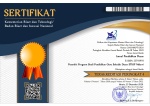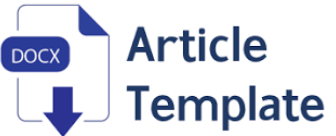Analysis of Smartphone Application Mastery in Distance Learning for Deaf Children in Secondary School
DOI:
https://doi.org/10.46368/jpd.v9i1.348Abstract
Abstract: Distance learning is a learning model that is applied as one of the policies of the world government in the field of education to break the chain of the spread of the covid-19 virus. Many problems occur during distance learning, including in special education, one of which is deaf children, where deaf children have barriers in communicating but must follow learning without meeting in person in the classroom. This study aims to find out what information technology is most mastered by deaf children as a means of supporting distance learning. This research was conducted on deaf children at the high school level in extraordinary schools that during the covid 19 pandemic the school implemented an online learning system. This study uses descriptive analysis with the questionnaire filling method. Data collection is done by disseminating questionnaires containing questions related to the mastery of applications on smartphones aimed at deaf children. Furthermore, the data is analyzed using inductive and thematic analytics. Dai this research can be known that from the use of Whatsapp Application as a means of communication used to receive distance learning materials is 94.74%, zoom meeting application mastery rate 0.00%, then youtube application mastery level in receiving information 100.00%. And the most preferred time for deaf children to learn is free, which is 65.79%. So it can be concluded that the smartphone application that is most mastered by deaf children in high school in learning and receiving information is a Youtube application and the preferred time for deaf children in learning is free or unspecified.
Â
Keywords: Mastery of Smartphone Applications; Deaf Children; Distance Learning
References
Abidah, A., Hidaayatullaah, H. N., Simamora, R. M., Fehabutar, D., & Mutakinati, L. (2020). The impact of COVID-19 to Indonesian Education and its Relation to the philosophy of “Merdeka Belajar.†Studies in Philosophy of Science and Education, 1(1), 38–49.
Agarwal, M. S., & Dewan, D. J. (2020). An Analysis of the Effectiveness of Online Learning in Colleges of Uttar Pradesh during the COVID 19 Lockdown. Journal of Xi’an University of Architecture & Technology, ISSN, 1006–7930, 2957–2963.
Al-Balas, M., Al-Balas, H. I., Jaber, H. M., Obeidat, K., Al-Balas, H., Aborajooh, E. A., Al-Taher, R., & Al-Balas, B. (2020). Distance learning in clinical medical education amid COVID-19
pandemic in Jordan: current situation, challenges, and perspectives. BMC Medical Education, 20(1), 1–7.
Allyvia, R. N. (2018). Motivasi Berprestasi Anak Tunarungu. Fakultas Psikologi. Universitas Ahmad Dahlan Yogyakarta.
Beneke, A. J. (2020). Review of Justice on both sides: Transforming education through restorative justice. Education Review, 27.
Bhatti, Z., Muhammad, F., Malik, H. A. M., Hussain, M., Chandio, H., Channa, S., & Mahar, Z. (2021). Text to Animation for Sign Language of Urdu and Sindhi. IKSP Journal of Emerging Trends in Basic and Applied Sciences, 1(1).
Buli-Holmberg, J., & Jeyaprathaban, S. (2016). Effective practice in inclusive and special needs education. International Journal of Special Education, 31(1), 119–134.
Diningrat, S. W. M., Nindya, M. A., & Salwa, S. (2020). EMERGENCY ONLINE TEACHING: EARLY CHILDHOOD EDUCATION LECTURER PERCEPTION OF BARRIER AND
PEDAGOGICAL COMPETENCY. Jurnal Cakrawala Pendidikan, 39(3).
Grane, M., & Crescenzi-Lanna, L. (2021). Improving the Interaction Design of Apps for Children with Special Educational Needs. Journal of Educational Multimedia and Hypermedia, 30(2), 139–164.
Haenudin, H. (2013). Pendidikan anak berkebutuhan khusus tunarungu. Jakarta: PT Luxima Metro Media.
Heale, R., & Twycross, A. (2018). What is a case study? Royal College of Nursing.
Jannah, R. N., Wulandari, N. L., & Budi, S. (2020). Pengalaman Belajar Daring Siswa Berkebutuhan Khusus pada Pandemi COVID-19 di SD Inklusif. ELEMENTARY: Islamic Teacher Journal, 8(2), 359–376.
Kamhar, M. Y., & Lestari, E. (2019). Pemanfaat Sosial Media Youtube Sebagai Media Pembelajaran Bahasa Indonesia DI Perguruan Tinggi. Inteligensi: Jurnal Ilmu Pendidikan, 1(2), 1–7.
Kustyarini, K., Utami, S., & Koesmijati, E. (2020). THE IMPORTANCE OF INTERACTIVE LEARNING MEDIA IN A NEW CIVILIZATION ERA. European Journal of Open Education and E-Learning Studies, 5(2).
Mansur, R. (2018). Belajar jalan perubahan menuju kemajuan. Vicratina: Jurnal Pendidikan Islam, 3(1).
Millett, P. (2021). Tips for making Zoom accessible for students who are deaf or hard of hearing (powerpoint slides).
Moghavvemi, S., Sulaiman, A., Jaafar, N. I., & Kasem, N. (2018). Social media as a complementary learning tool for teaching and learning: The case of youtube. The International Journal of Management Education, 16(1), 37–42.
Nasution, W. N. (2017). Strategi pembelajaran.
Ogbonna, C. G., Ibezim, N. E., & Obi, C. A. (2019). Synchronous versus asynchronous e-learning in teaching word processing: An experimental approach. South African Journal of Education, 39(2).
Pawlak, M. (2019). Investigating language learning strategies: Prospects, pitfalls and challenges.
Language Teaching Research, 1362168819876156.
Pratiwi, B., & Hapsari, K. P. (2020). Kemampuan Berpikir Tingkat Tinggi Dalam Pemanfaatan
YouTube Sebagai Media Pembelajaran Bahasa Indonesia. Jurnal Ilmiah Sekolah Dasar, 4(2), 282–289.
Prawiyogi, A. G., Purwanugraha, A., Fakhry, G., & Firmansyah, M. (2020). Efektivitas Pembelajaran Jarak Jauh Terhadap Pembelajaran Siswa di SDIT Cendekia Purwakarta. Jurnal Pendidikan Dasar, 11(1), 94–101.
Putri, R. S., Purwanto, A., Pramono, R., Asbari, M., Wijayanti, L. M., & Hyun, C. C. (2020). Impact of the COVID-19 pandemic on online home learning: An explorative study of primary schools in Indonesia. International Journal of Advanced Science and Technology, 29(5), 4809–4818.
Salama, R., Uzunboylu, H., & Alkaddah, B. (2020). Distance learning system, learning programming languages by using mobile applications. New Trends and Issues Proceedings on Humanities and Social Sciences, 7(2), 23–47.
Secora, K., & Emmorey, K. (2020). Visual-Spatial Perspective-Taking in Spatial Scenes and in American Sign Language. The Journal of Deaf Studies and Deaf Education, 25(4), 447–456.
Setiadi, E. F., Azmi, A., & Indrawadi, J. (2019). Youtube Sebagai Sumber Belajar Generasi Milenial. Journal of Civic Education, 2(3), 313–323.
Setiawati, S. D. (2020). MOTIF PENGGUNAAN MEDIA YOUTUBE SEBAGAI MEDIA PEMBELAJARAN DIKALANGAN GURU ABK SLBN CICENDO KOTA BANDUNG. VISIONER, 2(2 Desember), 288–297.
Sharma, R. (2016). Effect of school and home environments on creativity of children. MIER Journal of Educational Studies, Trends and Practices, 1(2).
Van Lancker, W., & Parolin, Z. (2020). COVID-19, school closures, and child poverty: a social crisis in the making. The Lancet Public Health, 5(5), e243–e244.
Viner, R. M., Russell, S. J., Croker, H., Packer, J., Ward, J., Stansfield, C., Mytton, O., Bonell, C., & Booy, R. (2020). School closure and management practices during coronavirus outbreaks including COVID-19: a rapid systematic review. The Lancet Child & Adolescent Health, 4(5), 397–404.
Worster, E., Pimperton, H., Ralphâ€Lewis, A., Monroy, L., Hulme, C., & MacSweeney, M. (2018). Eye movements during visual speech perception in deaf and hearing children. Language Learning, 68, 159–179.
Zili, A. H. A., Kharis, S. A. A., & Lestari, D. (2021). Peramalan Tingkat Kematian Indonesia Akibat Covid-19 Menggunakan Model Arima. Jurnal Indonesia Sosial Sains, 2(1), 1–8.





